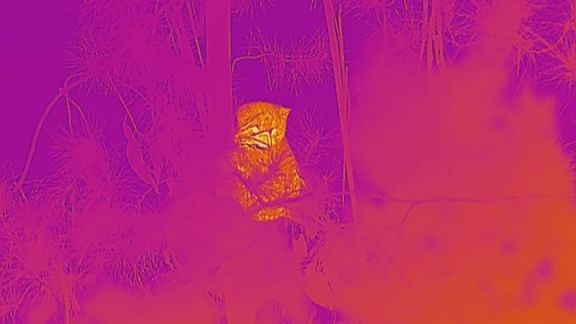AI tech to enable real-time koala detection in forestry operations
29 May 2024

Federation University researchers are developing artificial intelligence-driven technology that will allow a robot to identify koalas in gum tree plantations, alerting forestry groups to their location before any trees are harvested.
The research team, led by Associate Professor Gayan Kahandawa, was approached by multinational forestry services group PF Olsen, which has blue gum plantations in Victoria and had seen the ground surveillance robot the Federation team developed with African Parks.
That robot, dubbed GUS (Ground Unmanned System), was developed to alert African Parks rangers to the presence of organised poaching rings and other armed intruders and now will be adapted for a very different role.
Blue gum timber plantations are the preferred choice in paper manufacturing domestically and internationally because of the trees' exceptional fibre yield and cost-effectiveness.
The plantations, however, also serve as favourable habitats for koala populations and often have koala communities within them.
Mechatronics researcher Associate Professor Kahandawa from the Centre of Smart Analytics says the project will allow spotters to locate the koalas more safely and accurately. It will also generate significant cost savings for the timber group, which will need fewer resources to find the koalas.
"There are spotters on foot with thermal monoculars out in front of large mechanical harvesters looking for koalas before the harvesters get to those trees," he said.
"It is imperative for harvesters to ascertain the absence of koalas on the trees. If a koala is spotted, that tree and others around it are left alone. We need to do everything we can to protect them.
"Using the spotters is an effective way of locating koalas – the spotters also do a pass in the morning of the harvesting to check for them – but it is physically demanding for the personnel involved and it also exposes them to safety risks by requiring them to work near the harvesting machinery."
Associate Professor Kahandawa says the researchers will develop a robust and remotely operated robot with advanced AI vision capabilities designed explicitly for spotting koalas. It will feature top-mounted thermal and telephoto-lens cameras.
The innovative robot will offer real-time koala detection and share its location with highly accurate GPS coordinates. Operators can also control the robot remotely, benefiting from real-time visual data.
"There is potential to evolve this system into full autonomy in subsequent stages of development," Associate Professor Kahandawa said.
 PF Olsen contributed $175,000 to the project, which has recently begun and will run for one year. The researchers plan to have a working model by the end of 2024, with initial testing at a PF Olsen plantation at Hamilton in south-western Victoria early in 2025.
PF Olsen contributed $175,000 to the project, which has recently begun and will run for one year. The researchers plan to have a working model by the end of 2024, with initial testing at a PF Olsen plantation at Hamilton in south-western Victoria early in 2025.
Associate Professor Kahandawa says a key component of the project will be developing artificial intelligence to detect koalas.
"We will be able to identify koalas from other animals and large birds – the identification will be extremely accurate," he said.
"The cameras will also see any animals as thermal hotspots as well – the AI will take that identification to the next level."
CSA co-director Professor Joarder Kamruzzaman says the technology developed in the project could also be used in other applications.
"GPS technology is widely used in farms across Australia and is something we can tap into. In this instance, forestry is the application but it is something that could potentially be developed for agriculture. Farmers could be alerted to the whereabouts of stray animals using AI and the GPS coordinates that are already available," Professor Kamruzzaman said.
The project to develop GUS the robot comes soon after the researchers received funding from the CSIRO's Next Generation Graduates Program grant scheme to continue developing GUS for its role in Africa.
Associate Professor Kahandawa say that project will add significant capability to GUS, working with industry partner Outlook Industries Australia to develop the algorithms running the robot to make it fully autonomous.
Related reading:
Developing world-leading AI tech in regional Australia
Meet GUS – a robot to help in the fight against poaching


